Accounting fraud can be extremely costly for businesses, with the typical case resulting in a median loss of $117,000 according to the Association of Certified Fraud Examiners. To protect your organization, it’s important to understand the conditions that enable accounting fraud to occur. The fraud triangle is a framework that explains the three elements that must be present for an ordinary person to commit fraud: perceived financial need, perceived opportunity, and rationalization. In this article, we review the components of the fraud triangle and ways to mitigate risks for your business.
Table of Contents
- Perceived Opportunity
- Rationalization
- Perceived Financial Pressure
- Using Accounting Systems to Prevent Fraud
- The Bottom Line
Perceived Opportunity
The first leg of the fraud triangle is perceived opportunity. This occurs when employees believe they can commit accounting fraud without getting caught, often due to a lack of internal controls.
For example, Rita Crundwell, comptroller and treasurer of Dixon, Illinois, embezzled $53.7 million over 22 years by diverting city funds to a secret bank account. She was able to perpetrate the accounting fraud for so long because she had complete control over all financial functions with no oversight.
To reduce perceived opportunity:
- Implement segregation of duties so no single person controls all parts of a financial transaction from start to finish
- Require multiple approvals for expenditures over a certain dollar amount
- Separate handling of funds from record-keeping
- Mandate employee vacations and job rotations
- Perform regular account reconciliations and internal audits
Rationalization
The second element is rationalization – when perpetrators justify their unethical actions to themselves. Rationalizations for accounting fraud take many forms, such as “I deserve this money for working so hard” or “I’m just borrowing it.”
In one case, an accounts payable employee at Yale University rationalized stealing $40 million as “forced retirement contributions” because she felt the university should have paid her more. She used the funds to buy luxury cars, real estate and vacations.
Combat rationalizations by:
- Setting a strong ethical tone at the top through policies, training and leadership actions
- Providing an anonymous hotline for employees to report suspicious activity
- Consistently enforcing consequences for accounting fraud and unethical behavior
- Paying fair, market-based compensation to reduce resentment
Perceived Financial Pressure
The final fraud triangle factor is a perceived financial need that motivates accounting fraud. This could be a true financial hardship like medical bills or a gambling addiction, or a desire to maintain a lavish lifestyle.
For instance, the controller of Koss Corporation embezzled $34 million over 12 years to fund her shopping addiction, luxury vacations, and expensive jewelry. She felt pressure to maintain an extravagant image.
While you can’t control employees’ financial situations, you can reduce incentives to commit accounting fraud by:
- Implementing strict expense report reviews and approval workflows
- Restricting company credit card usage and requiring receipts
- Tracking company equipment and supplies
- Proactively monitoring for red flags like sudden changes in an employee’s spending habits or resistance to sharing financial duties

Using Accounting Systems to Prevent Fraud
A robust accounting system with strong internal controls is one of the most powerful tools for preventing and detecting accounting fraud. Here are some key ways to leverage your accounting software:
- Automate controls: Use system features to automate and codify preventive controls like segregation of duties, approval workflows, and access restrictions.
- Analyze data: Take advantage of built-in analytics to monitor for red flags and anomalies that could indicate accounting fraud, such as duplicate payments or unusual vendor activity.
- Restrict user access: Implement the principle of least privilege, giving employees access only to the specific system functions and data they need.
- Require audit trails: Ensure that all transactions are logged in the system with details on who performed them and when. Audit trails make it easier to identify unauthorized activity.
- Integrate bank feeds: Connect your accounting system directly to your bank to automate reconciliations and get alerted quickly to any discrepancies between your books and bank activity.
- Use AI or machine learning: Cutting-edge accounting platforms are starting to leverage artificial intelligence to analyze patterns, flag risky transactions, and continually improve accounting fraud detection.
By configuring your accounting system with strong access controls, approval workflows, audit trails and monitoring, you can significantly reduce opportunities for accounting fraud to occur and increase the likelihood of rapid detection if it does.
The Bottom Line
No organization is immune to accounting fraud, but you can significantly reduce your risk by understanding the fraud triangle and implementing a robust system of internal controls.
Some key recommendations:
- Establish a strong ethical culture with a zero-tolerance stance on accounting fraud. Provide fraud awareness training for all employees.
- Design internal controls focused on prevention and timely detection of accounting fraud. Implement segregation of duties, mandatory vacations, regular audits, and approval workflows.
- Leverage your accounting system’s built-in features to automate and strengthen controls. Restrict access, require approvals, analyze data for anomalies, and monitor audit trails.
- Proactively monitor for behavioral red flags of accounting fraud. Investigate and follow up on all tips from your reporting hotline.
- Consistently enforce anti-fraud policies and procedures. Take swift corrective action when accounting fraud is uncovered.
With the right controls and an anti-fraud stance, you can protect your business from becoming another accounting fraud statistic. Focus on reducing opportunity through oversight, setting an ethical tone to combat rationalizations, and proactively monitoring for signs of financial pressures or unusual activities. If your business needs help building systems and processes with improved accounting controls, contact us!

